Thermal Protection Mechanism of a Novel Adjustable Non-Ablative Thermal Protection System for Hypersonic Vehicles
Abstract
:1. Introduction
2. Physical and Numerical Models
3. Results and Discussion
3.1. Thermal Protection Efficiency at Non-Zero Angle of Attack
3.2. Thermal Protection Efficiency of Adjustable Non-Ablative TPS
3.3. Optimal Installation Angle
4. Conclusions
Author Contributions
Funding
Institutional Review Board Statement
Informed Consent Statement
Data Availability Statement
Acknowledgments
Conflicts of Interest
References
- Shoev, G.; Oblapenko, G.; Kunova, O.; Mekhonoshina, M.; Kustova, E. Validation of Vibration-Dissociation Coupling Models in Hypersonic Non-Equilibrium Separated Flows. Acta Astronaut. 2018, 144, 147–159. [Google Scholar] [CrossRef]
- Oscar, A.M.; Anurag, S.; Bhavani, V.S.; Raphael, T.H.; Max, L.B. Thermal Force and Moment Determination of an Integrated Thermal Protection System. AIAA J. 2010, 48, 119–128. [Google Scholar]
- Huang, J.; Yao, W.; Li, P. Uncertainty Dynamic Theoretical Analysis on Ceramic Thermal Protection System Using Perturbation Method. Acta Astronaut. 2018, 148, 41–47. [Google Scholar] [CrossRef]
- Qin, Q.; Xu, J.; Guo, S. Fluid-Thermal Analysis of Aerodynamic Heating over Spiked Blunt Body Configurations. Acta Astronaut. 2017, 132, 230–242. [Google Scholar] [CrossRef]
- Wang, S.; Zhang, W.; Cai, F.; Wang, Q.; Yan, C. Uncertainty and Sensitivity Study on Blunt Body’s Drag and Heat Reduction with Combination of Spike and Opposing Jet. Acta Astronaut. 2020, 167, 52–62. [Google Scholar] [CrossRef]
- Huang, W.; Li, L.Q.; Yan, L.; Zhang, T.T. Drag and Heat Flux Reduction Mechanism of Blunted Cone with Aerodisks. Acta Astronaut. 2017, 138, 168–175. [Google Scholar] [CrossRef]
- Vali, S.E.; Abbasi, S. Hypersonic Drag and Heat Reduction Mechanism of a New Hybrid Method of Spike, Multi-Row Discs and Opposing Jets Aerodynamic Configuration. Int. J. Heat Mass Transf. 2022, 194, 123034. [Google Scholar] [CrossRef]
- Mair, W.A. LXVIII. Experiments on Separation of Boundary Layers on Probes in Front of Blunt-Nosed Bodies in a Supersonic Air Stream. Lond. Edinb. Dublin Philos. Mag. J. Sci. 1952, 43, 695–716. [Google Scholar] [CrossRef]
- Huang, W.; Chen, Z.; Yan, L.; Yan, B.B.; Du, Z.B. Drag and Heat Flux Reduction Mechanism Induced by the Spike and Its Combinations in Supersonic Flows: A review. Prog. Aerosp. Sci. 2019, 105, 31–39. [Google Scholar] [CrossRef]
- Sun, X.; Huang, W.; Ou, M.; Zhang, R.R.; Li, S.B. A Survey on Numerical Simulations of Drag and Heat Reduction Mechanism in Supersonic/Hypersonic Flows. Chin. J. Aeronaut. 2019, 32, 771–784. [Google Scholar] [CrossRef]
- Wang, Z.G.; Sun, X.; Huang, W.; Li, S.B.; Yan, L. Experimental Investigation on Drag and Heat Flux Reduction in Supersonic/Hypersonic Flows: A Survey. Acta Astronaut. 2016, 129, 95–110. [Google Scholar] [CrossRef]
- Ji, C.; Liu, B.; Huang, W.; Li, S.; Meng, Z.; Yan, L.; Choubey, G. Design Exploration on the Drag Reduction and Thermal Protection over a Blunted Waverider with Multiple Opposing Jets. Aerosp. Sci. Technol. 2022, 124, 107519. [Google Scholar] [CrossRef]
- Wang, Z.; Zhang, X. Parametric Research on Drag Reduction and Thermal Protection of Blunt-Body with Opposing Jets of Forward Convergent Nozzle in Supersonic Flows. Acta Astronaut. 2022, 190, 218–230. [Google Scholar] [CrossRef]
- Hayashi, K.; Aso, S.; Tani, Y. Experimental Study on Thermal Protection System by Opposing Jet in Supersonic Flow. J. Spacecr. Rockets 2006, 43, 233–235. [Google Scholar] [CrossRef]
- Huang, W.; Jiang, Y.P.; Yan, L.; Liu, J. Heat Flux Reduction Mechanism Induced by a Combined Opposing Jet and Cavity Concept in Supersonic Flows. Acta Astronaut. 2016, 121, 164–171. [Google Scholar] [CrossRef]
- Ji, C.; Liu, B.; Huang, W.; Li, S.; Yan, L. Investigation on the Drag Reduction and Thermal Protection Properties of the Porous Opposing Jet in the Supersonic Flow: A Parametric Study with Constant Mass Flow Rate. Aerosp. Sci. Technol. 2021, 118, 107064. [Google Scholar] [CrossRef]
- Huang, W.; Zhang, R.R.; Yan, L.; Ou, M.; Moradi, R. Numerical Experiment on the Flow Field Properties of a Blunted Body with a Counterflowing Jet in Supersonic Flows. Acta Astronaut. 2018, 147, 231–240. [Google Scholar] [CrossRef]
- Huang, J.; Yao, W.; Jiang, Z. Penetration Mode Effect on Thermal Protection System by Opposing Jet. Acta Astronaut. 2019, 160, 206–215. [Google Scholar] [CrossRef]
- Shen, B.; Liu, W. Thermal Protection Performance of a Low Pressure Short Penetration Mode in Opposing Jet and Its Application. Int. J. Heat Mass Transf. 2020, 163, 120466. [Google Scholar] [CrossRef]
- Qu, F.; Sun, D.; Bai, J.; Zuo, G.; Yan, C. Numerical Investigation of Blunt Body’S Heating Load Reduction with Combination of Spike and Opposing Jet. Int. J. Heat Mass Transf. 2018, 127, 7–15. [Google Scholar] [CrossRef]
- Ou, M.; Yan, L.; Huang, W.; Li, S.; Li, L. Detailed Parametric Investigations on Drag and Heat Flux Reduction Induced by a Combined Spike and Opposing Jet Concept in Hypersonic Flows. Int. J. Heat Mass Transf. 2018, 126, 10–31. [Google Scholar] [CrossRef]
- Meng, Y.; Yan, L.; Huang, W.; Wang, Z. Fluid-Thermal Coupled Investigation on the Combinational Spike and Opposing/Lateral Jet in Hypersonic Flows. Acta Astronaut. 2021, 185, 264–282. [Google Scholar] [CrossRef]
- Huang, W. A Survey of Drag and Heat Reduction in Supersonic Flows by a Counterflowing Jet and Its Combinations. J. Zhejiang Univ.-Sci. A 2015, 16, 551–561. [Google Scholar] [CrossRef] [Green Version]
- Gerdroodbary, M.B. Numerical Analysis on Cooling Performance of Counterflowing Jet over Aerodisked Blunt Body. Shock Waves 2014, 24, 537–543. [Google Scholar] [CrossRef]
- Liou, M.S. A sequel to AUSM: AUSM+. J. Comput. Phys. 1996, 129, 364–382. [Google Scholar] [CrossRef]
- Menter, F.R. Two-Equation Eddy-Viscosity Turbulence Models for Engineering Applications. AIAA J. 1994, 32, 1598–1605. [Google Scholar] [CrossRef]
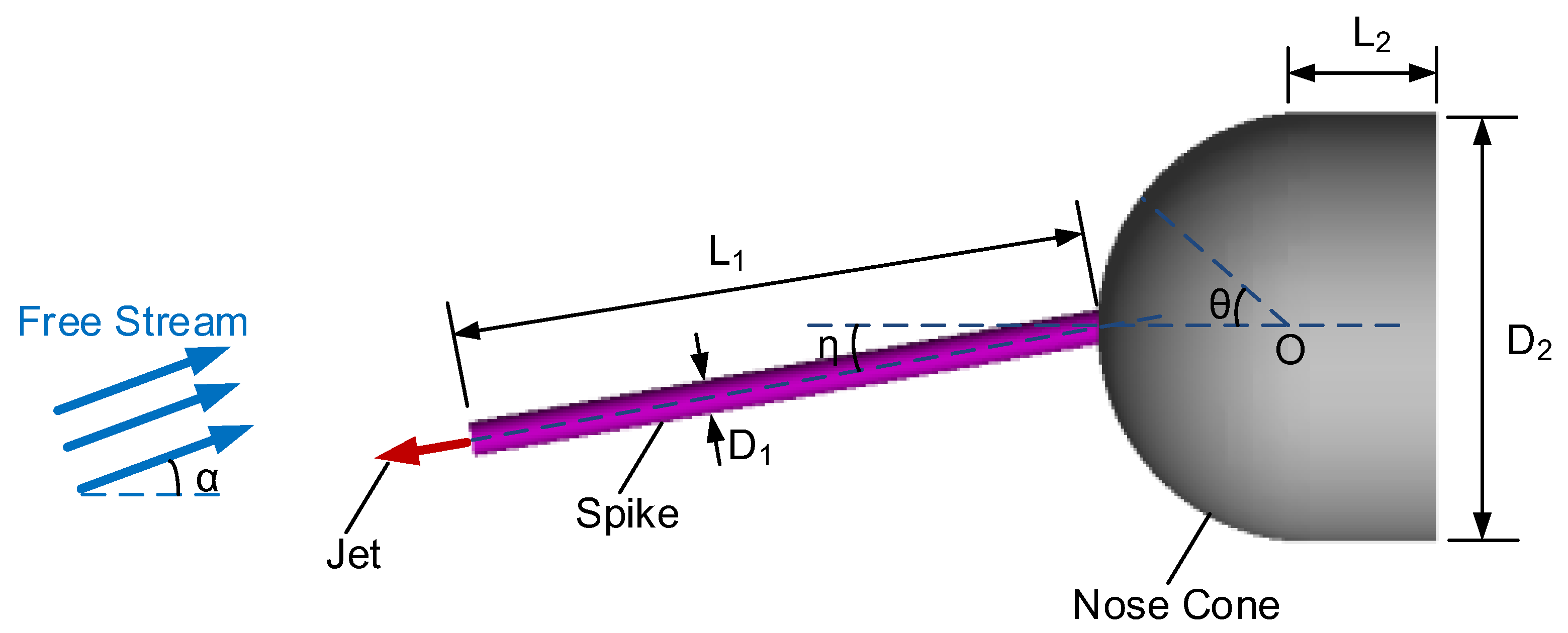
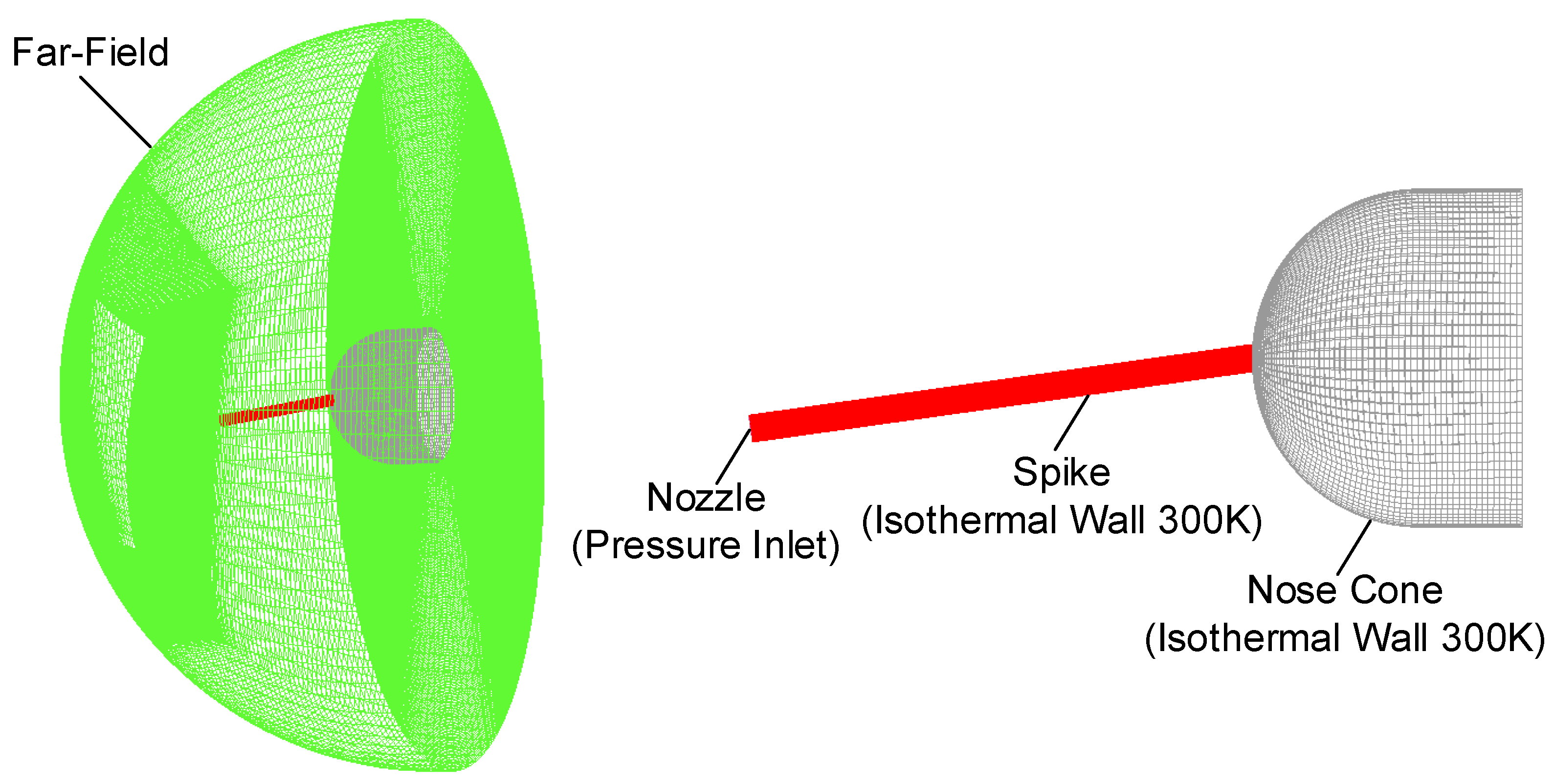

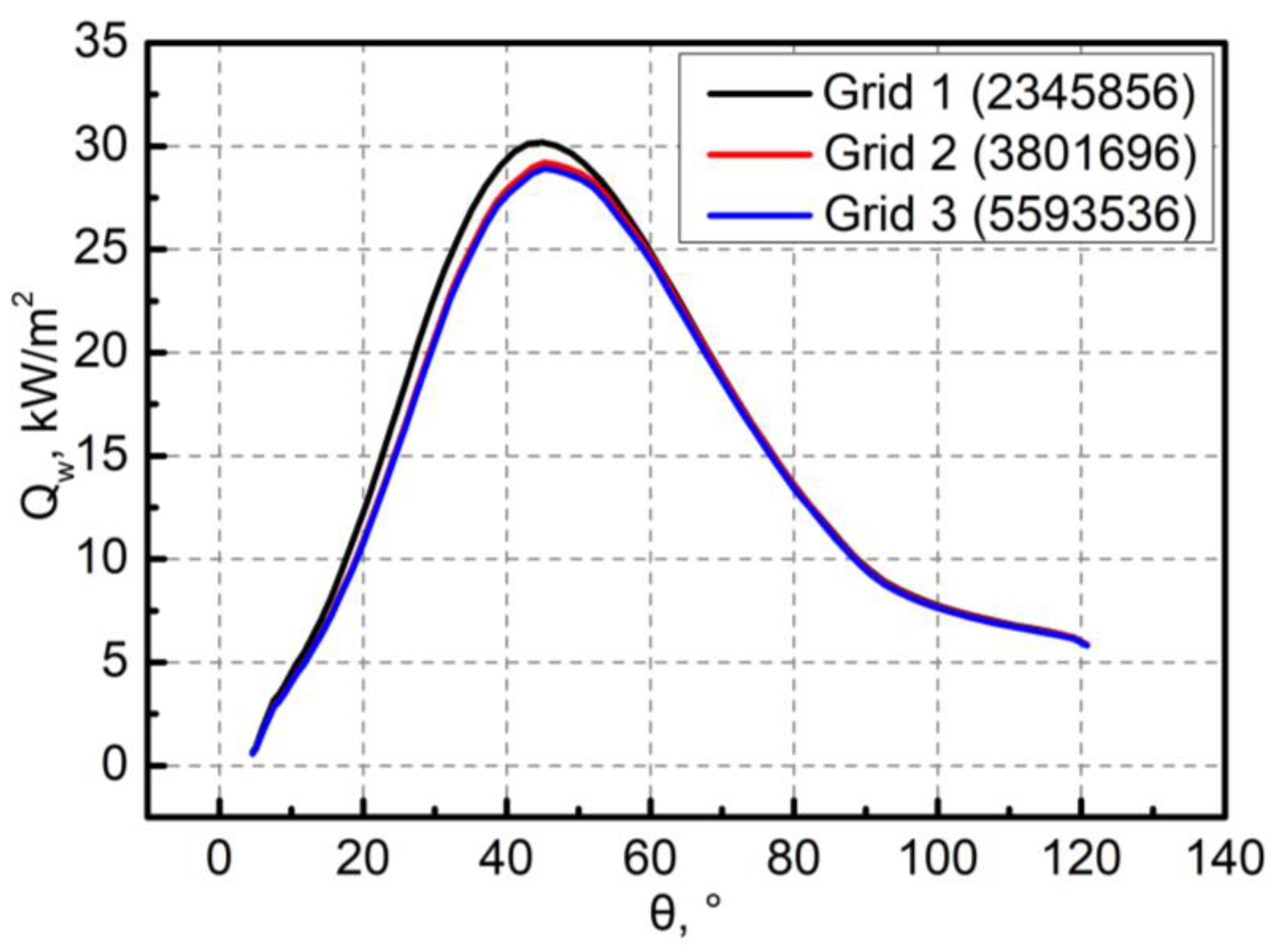
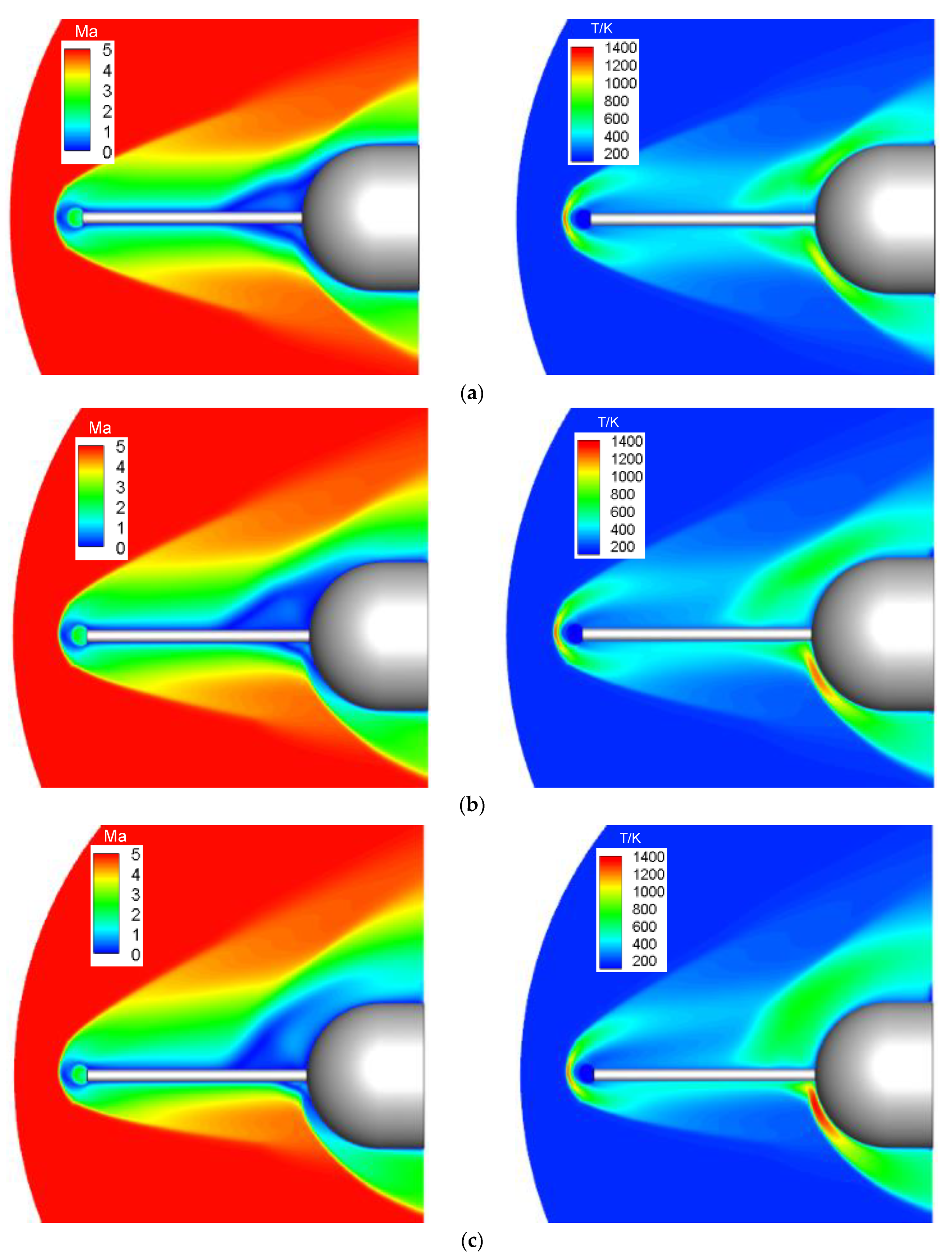
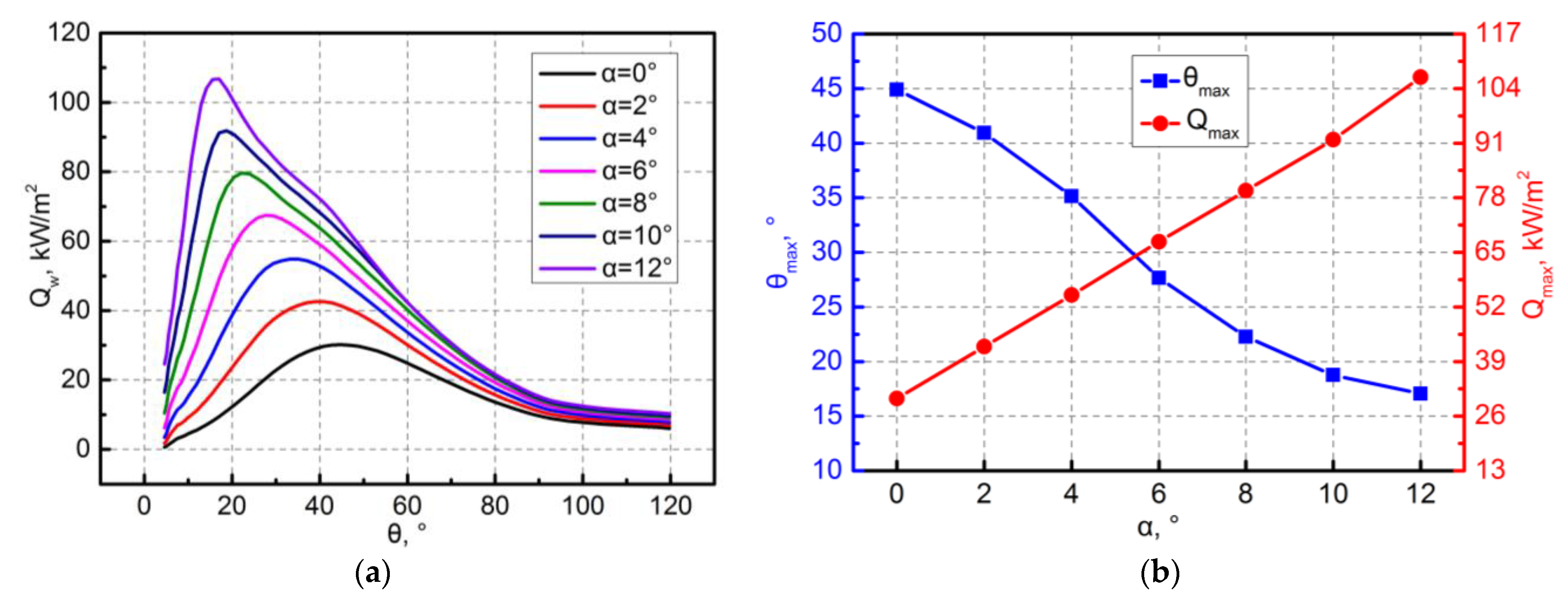


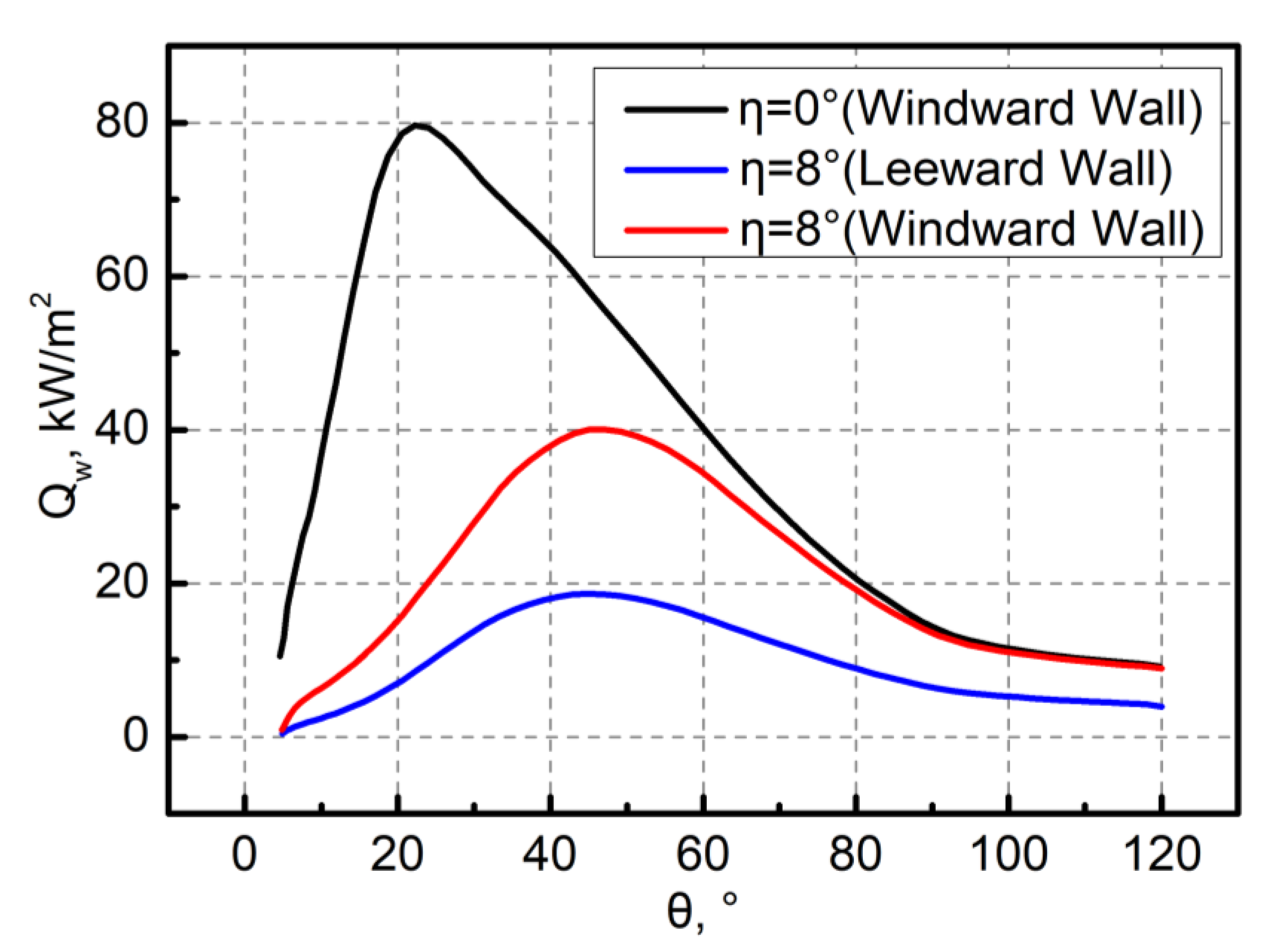


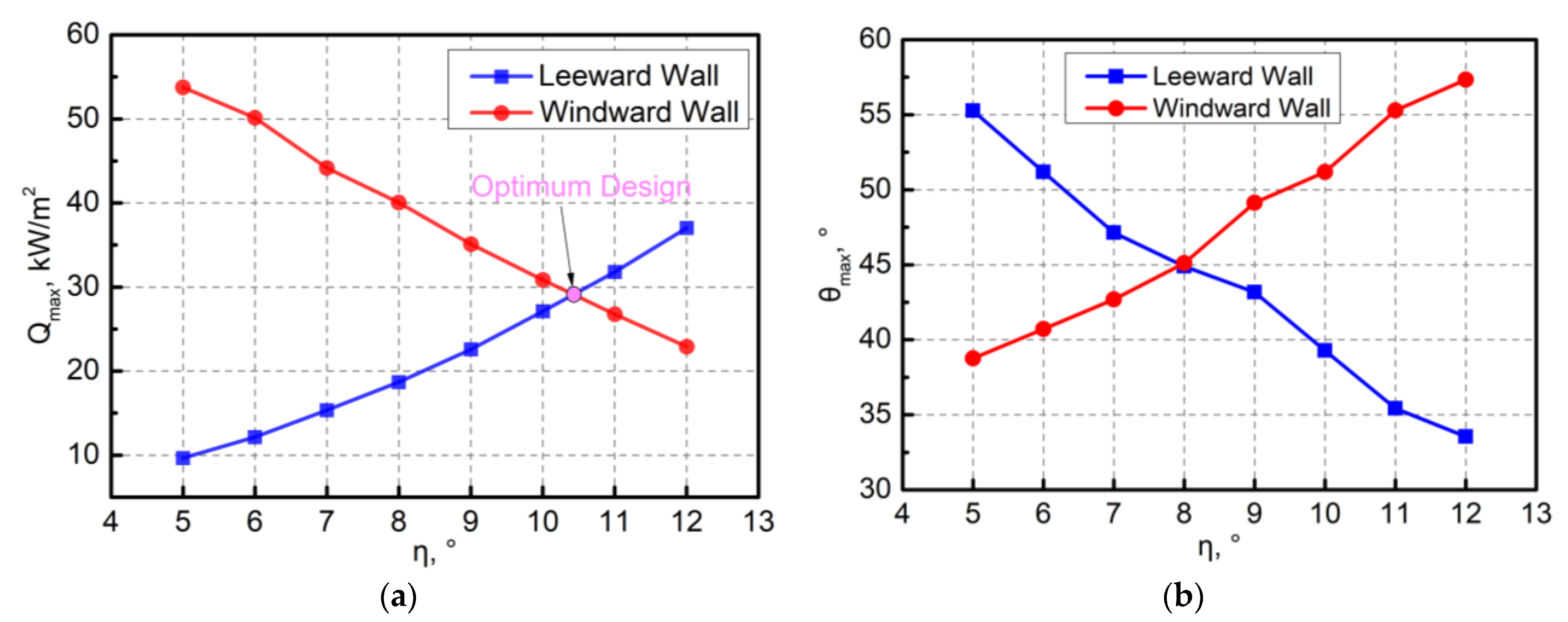
| L1 (mm) | L2 (mm) | D1 (mm) | D2 (mm) |
|---|---|---|---|
| 75 | 15 | 4 | 50 |
| Characteristic | Jet | Far-Field |
|---|---|---|
| Mach number | 1.5 | 5 |
| Static pressure (Pa) | — | 21.96 |
| Static temperature (K) | — | 247.02 |
| Total pressure (Pa) | 2323.6 | — |
| Total temperature (K) | 300 | — |
| Angle of attack (°) | — | 0 |
| Grid | Number | Qt (kW) | Qmax (kW/m2) |
|---|---|---|---|
| 1 | 2345856 | 94.77 | 30.18 |
| 2 | 3801696 | 93.24 | 29.19 |
| 3 | 5593536 | 92.78 | 28.90 |
| α (°) | 7 | 8 | 9 |
|---|---|---|---|
| ηopt (°) | 9.42 | 10.42 | 11.47 |
| ηopt-α (°) | 2.44 | 2.42 | 2.47 |
Disclaimer/Publisher’s Note: The statements, opinions and data contained in all publications are solely those of the individual author(s) and contributor(s) and not of MDPI and/or the editor(s). MDPI and/or the editor(s) disclaim responsibility for any injury to people or property resulting from any ideas, methods, instructions or products referred to in the content. |
© 2022 by the authors. Licensee MDPI, Basel, Switzerland. This article is an open access article distributed under the terms and conditions of the Creative Commons Attribution (CC BY) license (https://creativecommons.org/licenses/by/4.0/).
Share and Cite
Chang, B.; Huang, J.; Yao, W.-X. Thermal Protection Mechanism of a Novel Adjustable Non-Ablative Thermal Protection System for Hypersonic Vehicles. Aerospace 2023, 10, 1. https://doi.org/10.3390/aerospace10010001
Chang B, Huang J, Yao W-X. Thermal Protection Mechanism of a Novel Adjustable Non-Ablative Thermal Protection System for Hypersonic Vehicles. Aerospace. 2023; 10(1):1. https://doi.org/10.3390/aerospace10010001
Chicago/Turabian StyleChang, Bin, Jie Huang, and Wei-Xing Yao. 2023. "Thermal Protection Mechanism of a Novel Adjustable Non-Ablative Thermal Protection System for Hypersonic Vehicles" Aerospace 10, no. 1: 1. https://doi.org/10.3390/aerospace10010001
APA StyleChang, B., Huang, J., & Yao, W.-X. (2023). Thermal Protection Mechanism of a Novel Adjustable Non-Ablative Thermal Protection System for Hypersonic Vehicles. Aerospace, 10(1), 1. https://doi.org/10.3390/aerospace10010001





